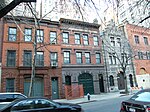Temple Israel of the City of New York
Brutalist architecture in New York CityBrutalist synagoguesGerman-Jewish culture in New York CityNeoclassical synagoguesReform synagogues in New York City ... and 6 more
Religious organizations established in 1873Synagogues completed in 1907Synagogues completed in 1922Synagogues completed in 1967Synagogues in ManhattanUpper East Side

Temple Israel of the City of New York is a Reform congregation in Manhattan. It was incorporated in 1873 by German Jews.It purchased its first synagogue building Fifth Avenue and 125th Street in 1887, constructed its own at 201 Lenox Avenue and 120th Street in 1907, and constructed another at 210 West 91st Street in 1920. Its current Brutalist style building, at 112 East 75th Street on the Upper East Side, was completed in 1967.Since its founding, Temple Israel has been served by only five senior rabbis: Maurice H. Harris (1882–1930), William Rosenblum (1930–1963), Martin Zion (1963–1991), Judith Lewis (1991–2006), and David Gelfand since 2006.
Excerpt from the Wikipedia article Temple Israel of the City of New York (License: CC BY-SA 3.0, Authors, Images).Temple Israel of the City of New York
East 75th Street, New York Manhattan
Geographical coordinates (GPS) Address Website External links Nearby Places Show on map
Geographical coordinates (GPS)
| Latitude | Longitude |
|---|---|
| N 40.7725 ° | E -73.9618 ° |
Address
Temple Israel
East 75th Street 112
10021 New York, Manhattan
New York, United States
Open on Google Maps






